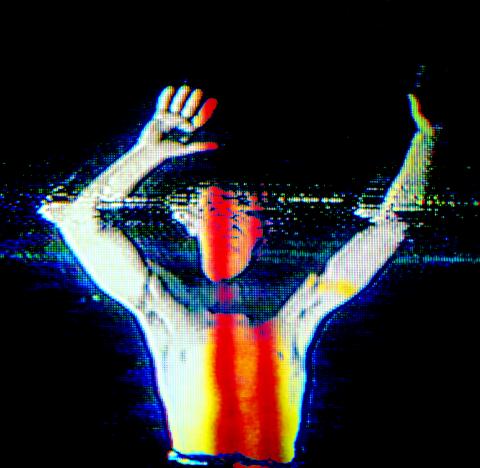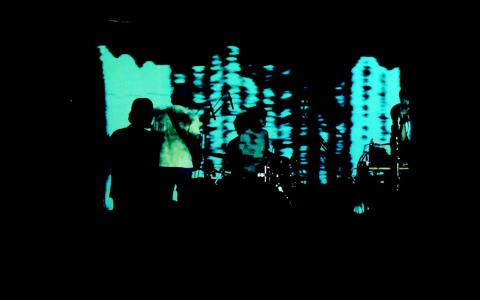After spending the last three or four years building a following by playing some of the most viciously fun live shows in Taipei’s underground rock scene, Forests (森林合唱樂團) are now leading that scene into ever weirder and more unexplainable directions.
They used to be indie rock, or garage rock, or lo-fi, but really though, they were always best at describing their own music. After their second album, No Fun (2014), they said they were “Sweater punk? Psychedelic surf rock? Garage Woo Woo Woo.”
That and the first album, The Moon Is Man (2012), were full of two-minute tightly knit songs that sort of teleported 60s doo-wop, surf rock and psychedelic radio hits into punk rock and post-90s fuzz. There was real structure in those songs, even if the band was consciously trying to unravel the weave of the music as they played it, with heavy distortion, moments of discord and a looseness that told you, we don’t care if the wheels fall off, we’re going to drive faster anyway. But whatever was happening, you could still smile your ass off and mosh to it.

Photo courtesy of Forests
There was also no question that Forests had assembled three of the best musicians in Taipei’s scene, the New Jerseyite Jon Du (杜澤威) on vocals and guitar, Tseng Kuo-hung (曾國宏) on bass and Lo Zun-long (羅尊龍) on drums. Well, actually, when it came to the wah-wah-wahs, they all sang.
The release of Forests’ third and newest album, Dead Species, on Wednesday night at The Wall was a full-on indie scene event, packing out the club with around 400 — and The Wall doesn’t get crowds like that very often anymore. For three hours, including sets by like-minded groups WWWW (落差草原) and Scattered Purgatory (破地獄), everyone sort of waited for the joyous explosion, one of those crazy hooks that always seemed to burst out of at least every other Forests song at their gigs two years ago. Except this time the hook was always kept dangling out there, like some will-o-the-wisp, as the band played a long, conceptual groove that kept leading deeper and deeper into a weird territory that is maybe best explained as art rock.
Sure, bands have been arty since at least the Talking Heads, but art rock is now gaining common currency in indie-dom. The trend is about bands who also create, or at least emulate, the type of contemporary art you see in galleries or museums, especially the weirder stuff like installation or symbolic performance art. Often the music is not considered an end product, but instead a part of the band’s larger artistic statement. As for the sounds, they often incorporate noise, field recordings, computer generated sounds or other experimental sources.

Photo courtesy of Forests
In some ways, it’s pretty extraordinary how indie rock has aped the art world, following the lead of the white cube of the gallery by turning the live house into a black cube, its own form of an empty canvas. Both pose as avant-garde movements who stand in opposition to the mainstream, elevated by the key ontological ingredient of “meaning.” Both are patronized by a self-styled intellectual elite, who are not bothered that most of the world doesn’t understand what the hell they are trying to express.
Having lost the larger audience — to EDM, but that’s another story — it’s like indie rock is trying to save itself by initiating punk rock all over again — trying to rescue itself through small, highly personal live gigs, and by creating the scene first, and not really worrying about commercial products like finished songs.
Obviously there’s a good and a bad to this, and Forests is now riding the edge. Their gig experiments, to their credit, have been cool deconstructions of what a gig is supposed to be. For last year’s NoWhere Party, they turned a band practice studio into a kind of art rock haunted house, with at least a dozen dark, 20-person-capacity rooms filled with all sorts of surprises: installation art, freeform jams, DJ sets and, if you were lucky, a band.
A few months ago for another show with WWWW and Scattered Purgatory, they used two stages so the bands could overlap in one continuous set of music that lasted over three hours, like one big musical cloud. Wednesday’s album release also included video art, while the club’s entrance area played rhythmic metallic scraping noises that were a version of the album stripped of bass, vocals, guitar and drums — basically all the sounds created by humans.
As for the new album itself, the rock trio that played two-minute songs has now moved on to plodding, industrial synth beats and spoken-word style vocals that channel the drugged out ravings of Jim Morrison. Tseng’s basslines are still compelling. Lo’s drumming has as much tribal urgency as ever. But now the groove feels like it’s on walkabout in an experimental wilderness. It’s uncomfortable for some fans. The days of happy moshing seem to be over. Maybe there is a greater meaning to this, and someday the world will come to understand its genius. But that is the promise of art rock, and also its great danger. As a fan of Forests, I do not want to begrudge them their experimental phase, but at the same time, I hope it won’t last forever.

May 11 to May 18 The original Taichung Railway Station was long thought to have been completely razed. Opening on May 15, 1905, the one-story wooden structure soon outgrew its purpose and was replaced in 1917 by a grandiose, Western-style station. During construction on the third-generation station in 2017, workers discovered the service pit for the original station’s locomotive depot. A year later, a small wooden building on site was determined by historians to be the first stationmaster’s office, built around 1908. With these findings, the Taichung Railway Station Cultural Park now boasts that it has

The latest Formosa poll released at the end of last month shows confidence in President William Lai (賴清德) plunged 8.1 percent, while satisfaction with the Lai administration fared worse with a drop of 8.5 percent. Those lacking confidence in Lai jumped by 6 percent and dissatisfaction in his administration spiked up 6.7 percent. Confidence in Lai is still strong at 48.6 percent, compared to 43 percent lacking confidence — but this is his worst result overall since he took office. For the first time, dissatisfaction with his administration surpassed satisfaction, 47.3 to 47.1 percent. Though statistically a tie, for most

Wooden houses wedged between concrete, crumbling brick facades with roofs gaping to the sky, and tiled art deco buildings down narrow alleyways: Taichung Central District’s (中區) aging architecture reveals both the allure and reality of the old downtown. From Indigenous settlement to capital under Qing Dynasty rule through to Japanese colonization, Taichung’s Central District holds a long and layered history. The bygone beauty of its streets once earned it the nickname “Little Kyoto.” Since the late eighties, however, the shifting of economic and government centers westward signaled a gradual decline in the area’s evolving fortunes. With the regeneration of the once

In February of this year the Taipei Times reported on the visit of Lienchiang County Commissioner Wang Chung-ming (王忠銘) of the Chinese Nationalist Party (KMT) and a delegation to a lantern festival in Fuzhou’s Mawei District in Fujian Province. “Today, Mawei and Matsu jointly marked the lantern festival,” Wang was quoted as saying, adding that both sides “being of one people,” is a cause for joy. Wang was passing around a common claim of officials of the People’s Republic of China (PRC) and the PRC’s allies and supporters in Taiwan — KMT and the Taiwan People’s Party — and elsewhere: Taiwan and